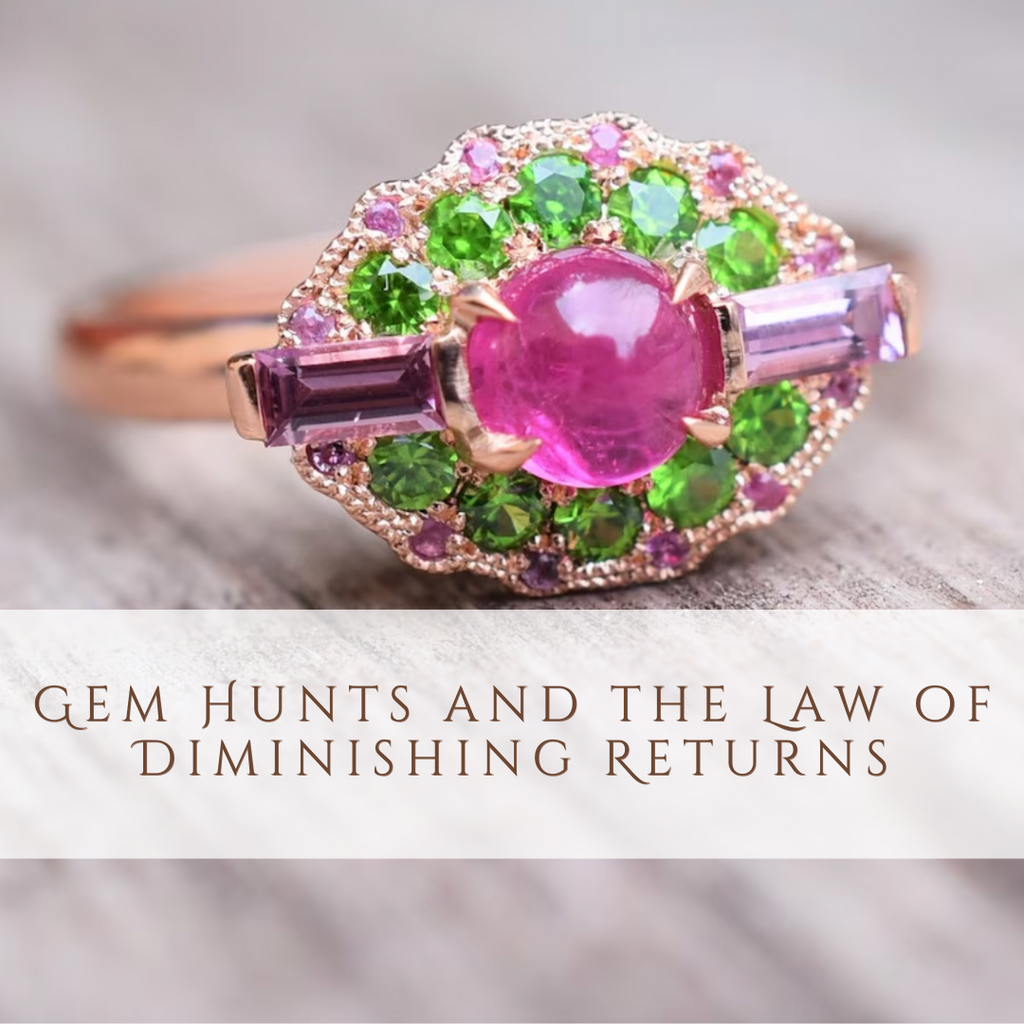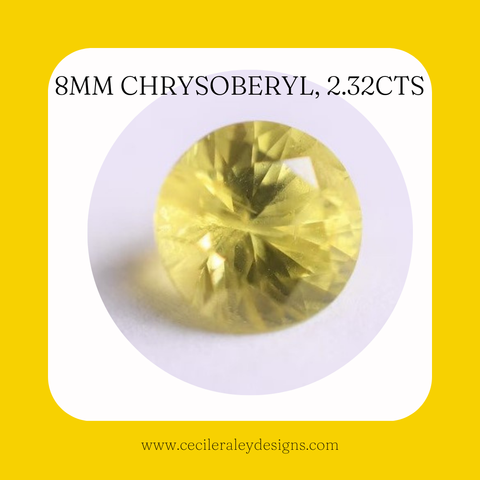Gem Hunts and the Law of Diminishing Returns: How and When to Compromise

I’m sure you have noticed this too but prices in the gem world have been nuts lately, and while the increases seem to have leveled off, decreases are not to be expected. More people are buying colored gems now, and ground level (where the gems are mined) has pushed prices up, while demand is not keeping up, or prices would be lower! So, how can you still win when no matter how close you get to the source, prices are not deflating? Let me tell you how I handle my buying, and maybe this will be helpful to you.
First, a more minor point: don’t get too scared about prices being higher than you are used to. The first rule in any kind of trading or investment is that if you are buying in a rising market, the initial cost is much less of a big deal. As a retail buyer, you may need to keep the gems longer but that is true for any kind of investment, even if you are buying stocks on the internet as a private individual rather than a bank or investment company that has a higher buy in. Focus on what is going to happen, not what did happen. The first hamburger McDonald’s sold cost 15 cents. Yours won’t.
With this issue out of the way, let’s look at how to compromise when you are buying gems. And how NOT to. Let’s start with the three most important aspects of colored gems and how to order them: Color, Cut/Shape, Clarity. Then let’s take into consideration origin and treatment.
Color
So here is where I do not compromise. Because the first thing you see in a gem is the color. You see it before the inclusions, and before you ascertain the shape. A brightly colored gem can be seen from across the room and out of the corner of the eye, and you will get pleasure mostly from the color. If you don’t like the color, you will fall out of love with the gem. We react strongly to color, all of us (yeah, even people who don’t like gems like sunsets and green meadows and flowers and the turquoise waves of a gorgeous beach). Accept it and move on.

This demantoid (see it here on Etsy) is lightly included but this doesn't detract from its vibrant apple-green color:

This Greenland ruby (on Etsy here) has stunning color but there is a small white feather on the left in the photo. It's invisible to the naked eye and shows up only in magnified pictures.

Cut/Shape
I have to buy gems that work for my settings to make things easier for you, so I cannot always compromise on cut. Though if I could, I would. But let me be clear, I mean that I would compromise on the overall shape, not on a wonky cut. I can design around any shape whatsoever and I can adapt styles to fit shapes. Layout styles are like that, they are very adaptable, you just need the right sidestones or you need to place the center a different way, like East - West. You can accommodate a long marquis or fat pear shape and still make a nice ring. If I had free choice, I would just forget shape altogether.
I would not forget about cutting, although you don’t need top quality cutting unless that’s sort of what pulls you in (all my cutter friends prioritize cut over color, which makes sense). You don’t want window, but don’t forget that richly colored stones obscure window, and then it’s ok. You don’t want to see it, that’s what matters. That should be sufficient if you need to save. Ignore tilt window, it is standard in many cuts and with lighter gems. And consider that some gems, i.e., pigeon blood ruby, are cut with some window because otherwise the gem is too dark.

I would also ignore extinction because most of the time you see the gem when it’s moving and then your eye will not be drawn to it. Real window though cannot be ignored, and a stone that is too dark can’t be ignored either (so in that sense, extinction is relevant).
Clarity
This is where the law of diminishing returns comes in. For a loupe clean gem you can pay up to double per carat. And who needs that? I don’t. In fact, when I judge gems at first pass I do not loupe them. For me, a loupe is used to confirm pricing, and to rule out inclusions that affect setting.

This round chrysoberyl (here on Etsy) looks silky to the naked eye but, when louped, there are small inclusions. The price is a steal given the size and the almost neon color.

Remember I offer to set all stones that I sell so it is in my own best interest to make sure they can handle setting. That’s why I don’t sell apatite or Mexican fire opal, and only smaller rhodochrosites. Vendors that sell only gems need not be concerned with that, and often they aren’t, or they don’t know how to look for that because they don’t make jewelry. So the job falls to me as a gem seller and jeweler. It is in my own best interest not to acquire stones like that. But for instance, a Paraiba can be included, even slightly windowed if it has enough color, it can be a marquis or pear, and all that will make it more reasonable to acquire. Just no scary inclusions.
Origin
This is a bit of a matter of taste. If you want a Burma ruby then you can’t compromise. But if another origin is just as beautiful to you, then why not get another origin? For example, a blue Madagascar sapphire can often look very similar to a Ceylon Sapphire, and initially even labs were confused because they did not have enough comparison data when Mada stones first hit the market. Mozambique rubies are often redder than Burmese rubies, and they cost less. More Mozambique rubies will be deemed pigeon blood than Burma, and a nicer alternative to Burma if you ask me is Afghanistan. They look more similar to my eye than Mozambique and Burma rubies do. Precisely because origin affects price, I often go with an unusual origin if I think I can find better quality.
A sidebar here on Paraiba. The reason I do not buy many Mozambique Paraiba is precisely because I feel that the price is not justified. The color is often not the same as Brazilian, even though many Mozambique gems are cleaner. And the prices are not always lower, so for me it’s not a win-win. There are exceptions but as a rule, I favor more included Brazilian stones because of the intense color.
Treatment
This could be a blog in itself but let me just touch on a few things really quickly so you get at least a sense. If treatment is not durable, that is an issue. Some zircons that are heat treated revert their color, especially the peach and brown tones. A heavily oiled emerald may start showing fissures and cracks later. Same with a Paraiba. They are also not stable for setting, steam or ultrasonic. Heat treated sapphires, on the other hand, will be cheaper, often glowier and more neon blue. At that point I would say that is a personal choice, but if the price is right and you love the stone I’d say go for it. Personally, I would buy a heated blue sapphire for keeps. But not a heavily oiled emerald. And no diffusion treatment or glass filling, though that is simply because at that point you are looking at very low value gems.
The main thing is that you pay the right price for what you are buying (therefore, on occasion, you will need a lab report to verify origin or treatment, and therefore price). And treatment affects price, just like everything else.

Ok that was a lot, as usual. Perhaps let’s boil it down to its simplest terms. Don’t compromise on color, do compromise on shape, and determine if you like it without a loupe. Double check price and rule out problems with the loupe. Must have that flawless stone? I think that often it’s not worth it. I’ll get you flawless stones if you want them, I just personally don’t think it’s necessary, especially if you need to be on a budget and you are not trading in gems for a living!
